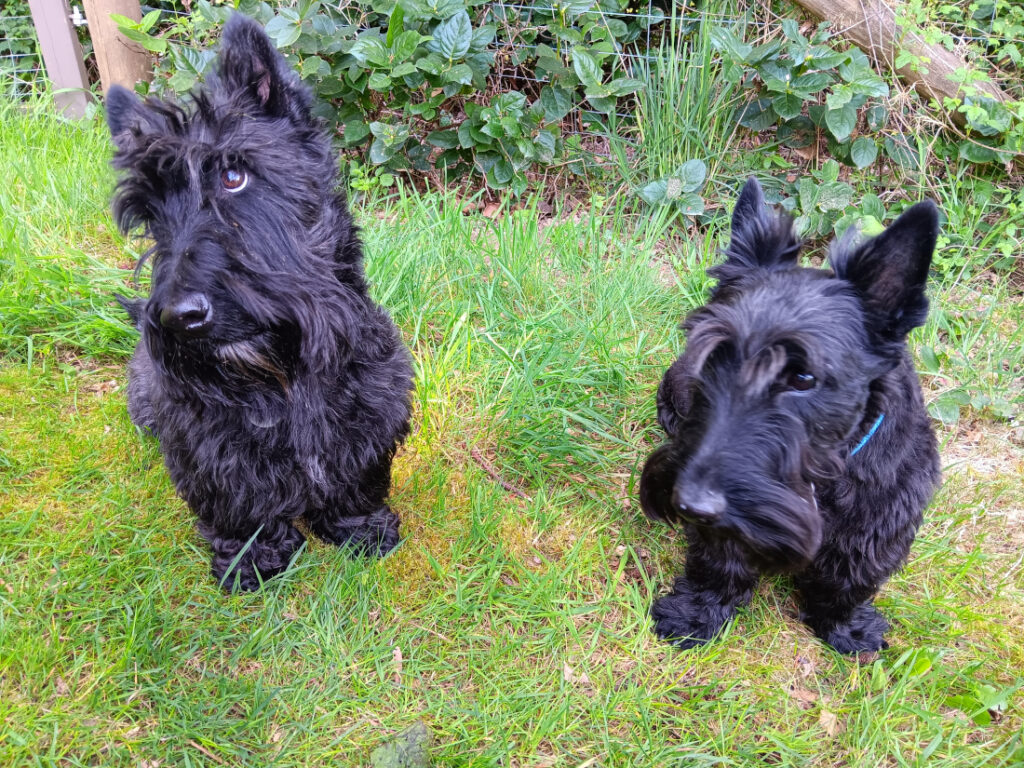By Michael Shook
Almost 20 years ago, I at last fulfilled a childhood yearning, and acquired my first Scottish Terrier. I had wanted one ever since reading Marjorie Flack’s delightful series of children’s books about a Scottie named Angus. Additionally, the books of James Thurber (who had Scotties himself), were a fixture in our house, and Scotties figured in more than one of his stories. And of course, one of his best known “fables” is “The Scottie Who Knew Too Much.” Clearly, I was primed for one.
Unfortunately for my childhood self, the old man replied to my pleading for a Scottie with, “No. They’ve got teeth like a German Shepherd. And they bite.” This puzzled me, since we had a German Shepherd, who did bite (if only once – that’s another story), so what was the difference?
I grew up, Scottie-deprived, with the aforementioned German Shepherd, who was a lovely dog despite the one-off biting. She was a great companion, easily trained to do the usual things – sit, stay, come. In the years since, I’ve had a handful of dogs that were likewise, mostly Labs, with a Lab/Chesapeake mix thrown in, a Golden Retriever, and a Bernese Mountain Dog. All of them learned the basic commands, and obeyed them well enough, so naturally I thought myself a competent dog trainer.
Then I got a Scottie. And then another. And I soon learned that, as a trainer, I’m middling at best. Not incompetent, surely, but not up to the mark, either. It’s my fault of course, though I feel the Scotties ought to bear some responsibility. They have an innate comic aspect that overcomes my best efforts to be stern. Absurdly cute, scampering about on their short legs, they resemble stuffed toys (albeit fierce, bitey ones).
Yet, for all their antic clowning, when at rest their countenance – foremost their expressive gaze – conveys gravitas, as if a dark responsibility rested upon their stout shoulders. The combination leaves me well short of the rigor necessary to bring the beast that is the Scottish Terrier to behave. In truth, I indulge them dreadfully, and with a Scottie, this is fatal.
I can’t say I wasn’t warned about their character. Researching the breed, I kept coming across statements like “In the absence of firm, consistent training, Scotties will run roughshod,” and “The Scottish Terrier is possibly the most independent, stubborn, and wilful of all the Terrier breeds.” After a while, I thought, well, how wilfully independently stubborn can they be? The answer was, much more than I could imagine.
Even the simple command, “Come!” is forever in doubt as to the desired result. If the Scottie in question is not otherwise engaged – and that could mean anything from hunting something to gazing soberly off into the distance – it might come. Then again, it might not. Frequently, my two will look at me, and then casually walk in the other direction. Sometimes they just turn, and sit with their backs to me. Their disdain is palpable, as if the very idea that I could assume the possibility – however remote – that they would do what I wish is distasteful to them, an insult to their dignity.
This is why you will never see a Scottie working as a guide dog for the blind. Another, perhaps more compelling reason, is that a Scottie’s prey drive is fearsome to behold. Unlike the carefully trained Labrador guide dog, which takes in, then ignores distractions, the Scottie, at the sight of a small creature – especially a rodent, but a bird will do, or sometimes even a bug – provokes a fury of Vesuvian proportion. It is a deeply personal affront to them that any such animal would dare show itself – nay, that it would even exist. They will chase it, and short of catching it and killing it, nothing will stop them. If a squirrel is on the other side of a busy street, or on a narrow ledge above a precipitous drop, the Scottie will still pursue. You can imagine the result if on the other end of the dog’s leash there clung a blind person.
The determination and courage of Scotties is boundless, whence comes their nickname “the Die-Hards.” Alas, not so their judgment, which is why a Scottie’s worst enemy is often himself. Originally bred to hunt foxes and badgers, in addition to rodents, they are ever-ready to fly into battle, and their animus is not confined to small creatures. They will attack and attempt to beat down and subdue (or sometimes kill) just about anything, including animals ten times their size. For example, the younger of my two, Walter, has it in for a Newfoundland that frequents the same coffee stand. It doesn’t matter to Walter that the Newfie’s head alone is roughly the same size as he. It must be made subordinate.
Given all this, my son-in-law once asked me why I would have such dogs. I wonder about that myself some days. In part, it’s their attitude, the way they carry themselves, their “Scottie-ness.” They are indeed “bold, jaunty” little fellows, always alert to a new sound or movement as they trot along, tails up, ears cocked forward, ready to meet any challenge, embrace any adventure. Though not remotely “lap-dogs,” they are, in their own way, quite affectionate, and deeply loyal. I can’t say more, except that I love them (even if they are so damned contrary – or maybe because they are), and they love me. What else is there?

